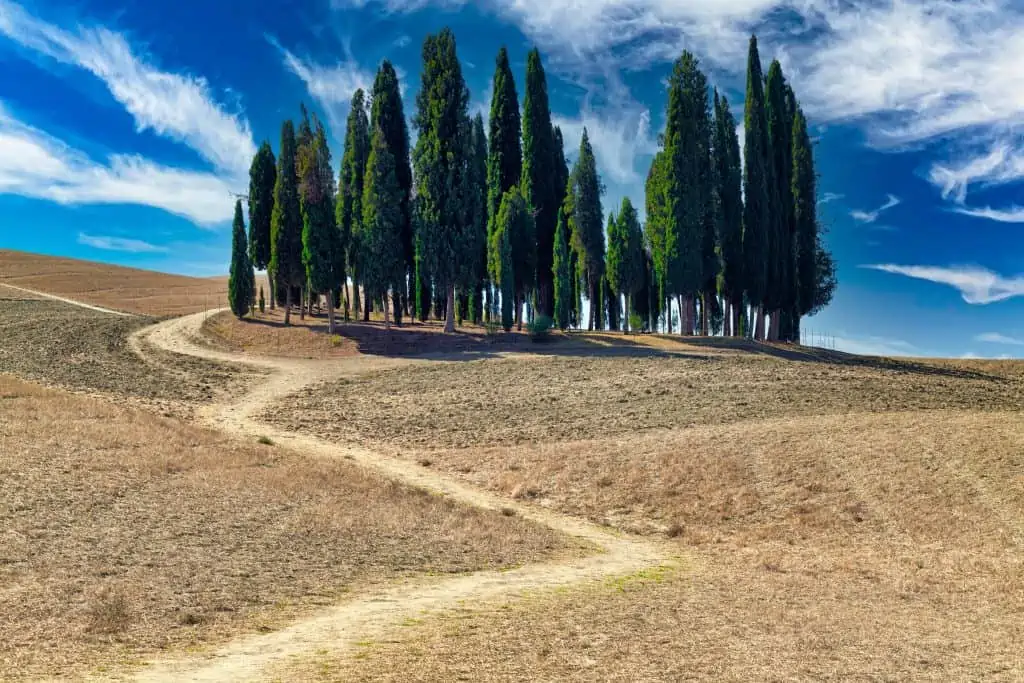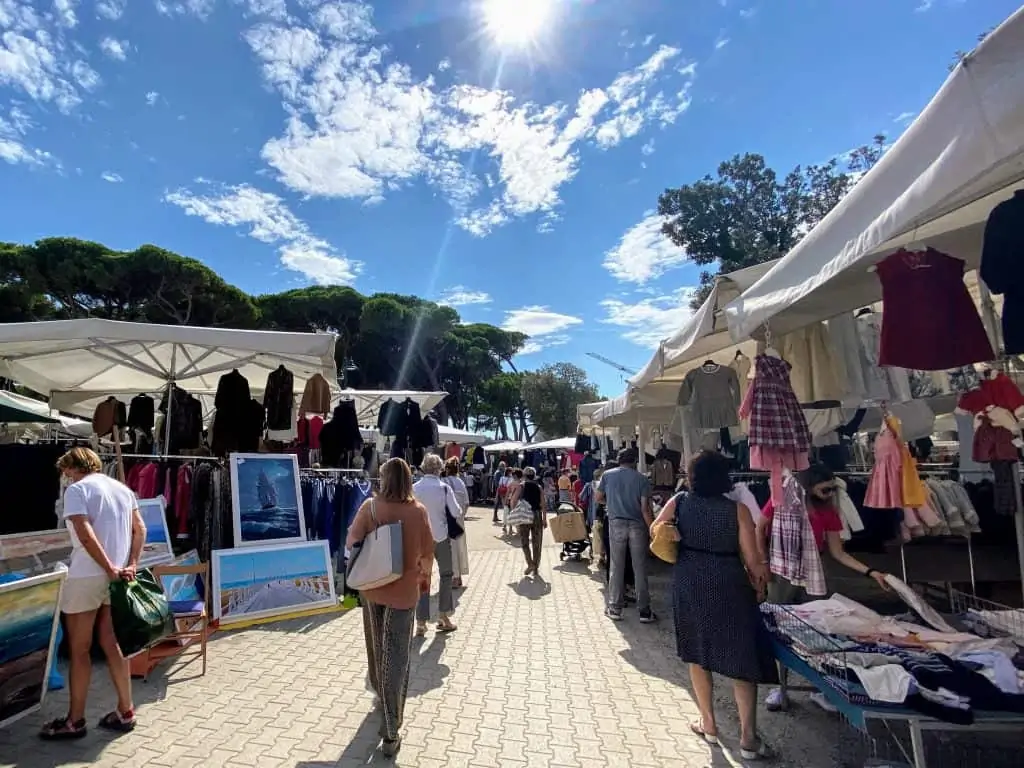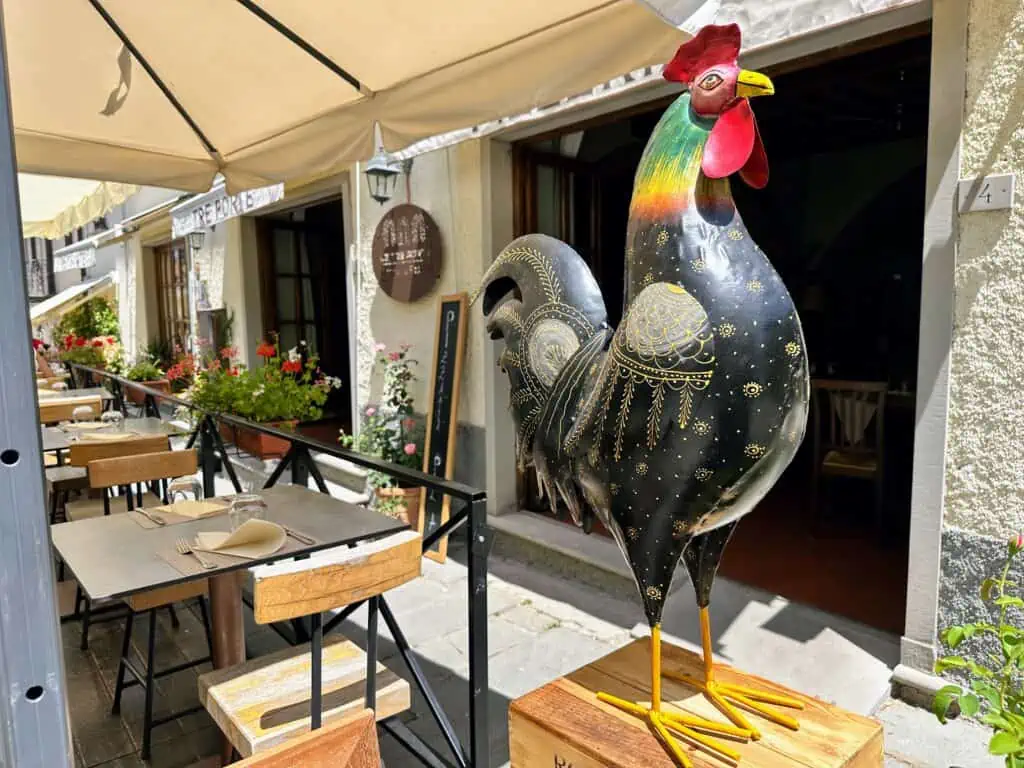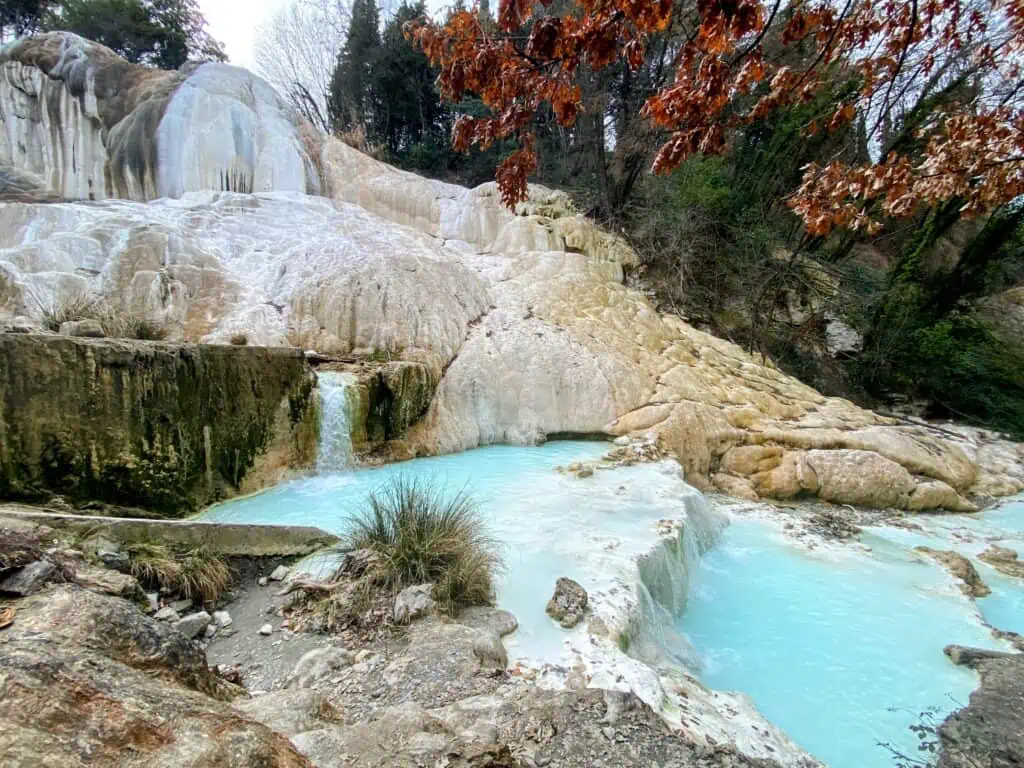When you think of Tuscany, one of the first images that pops into your head is probably a dirt road lined with cypress trees.
Tuscany has some iconic trees – the cypress, the olive tree, the umbrella pine, and the fig tree are just a few of them.
If you’re coming to Tuscany, you’ll see these trees everywhere you look. But, if you’re looking for the classic shots of Tuscany’s iconic trees, see our map below.
Table of Contents
Common Trees in Tuscany
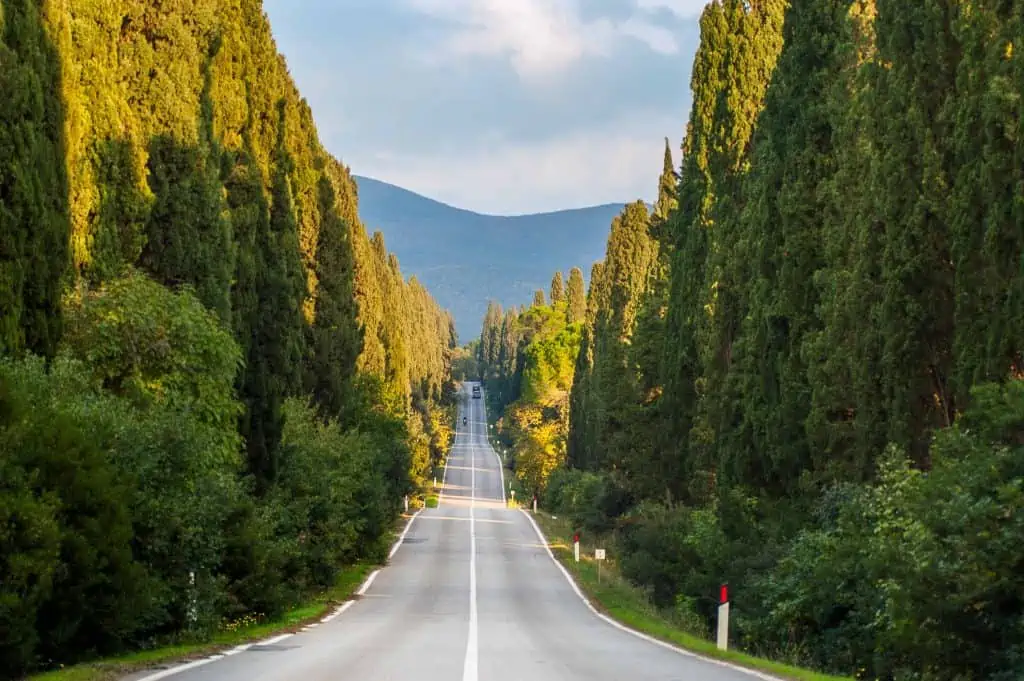
Cypress Trees
The cypress tree (cipresso in Italian) is a tall, thin evergreen conifer that originated in the Middle East. It’s also known as the Mediterranean cypress or the Italian cypress.
Often used as windbreaks on farmland, they’re also planted along roadsides and cemeteries in Tuscany.
You’ll see them throughout the region, but they’re especially concentrated (and striking) in the Val d’Orcia in Southern Tuscany.
Read about Visiting the Val d’Orcia
Olive Trees

The olive tree (olivo in Italian) is grown throughout Tuscany, in the rolling hills and by the seaside. Tuscany has four types of olive trees: Frantoio, Leccino, Moraiolo, and Pendolino.
Many families have olive groves, or even a few trees in their yard. Those that don’t have trees can still purchase high-quality, freshly-pressed olive oil in the grocery store each autumn.
Good To Know: Like many Tuscan families with olive groves, we typically harvest our olives in early November (but some harvest in late-October). It’s a multi-day process that involves shaking the olives into nets on the ground, gathering the olives into crates, and transporting them to the frantoio del comune (town olive press) where they’re pressed into a fragran, greenish-gold liquid.
In Tuscany, we use olive oil daily in cooking, with both hot and cold dishes. In the summer, it’s a staple of salad dressings for greens, and we drizzle it on bruschetta, tomatoes, panzanella and grilled meats. In the winter, we cook hearty dishes with it, and drizzle it on soups like ribollita.
Umbrella Pines
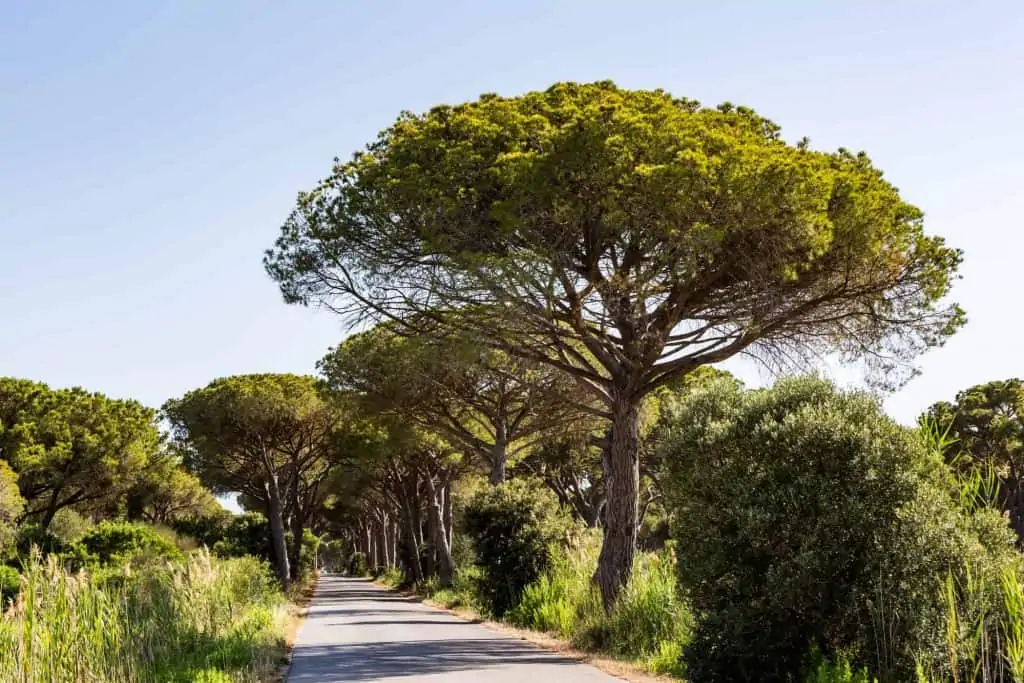
The umbrella pine (pino domestico, pino da pinoli, pino italico, l’ombrello pino, pino pignone in Italian) gets its name from its umbrella or mushroom shape. It is also known as the Italian stone pine. It’s native to southern Europe and Turkey and it loves a warm, dry climate.
The umbrella pine can live a long life, up to around 150 years, but the lifespan is considerably shorter in a city. They are anywhere from 40 – 80 feet tall.
The umbrella pine gives us the delicate pine nut, or pinolo. In Tuscany, we use pine nuts in baking like in the pinolata senese cake from Siena or the classic torta della nonna. We also sprinkle them on salads, add them to baked meat dishes like spezzatino di vitello, and use them in pesto recipes. They also make wonderful additions to warm dishes like caponata.
You’ll see them throughout the region, and especially near the seaside.
Umbrella pines will be your friend if you’re traveling through Tuscany in the summer – their canopies provide much-needed shade!
Fig Trees
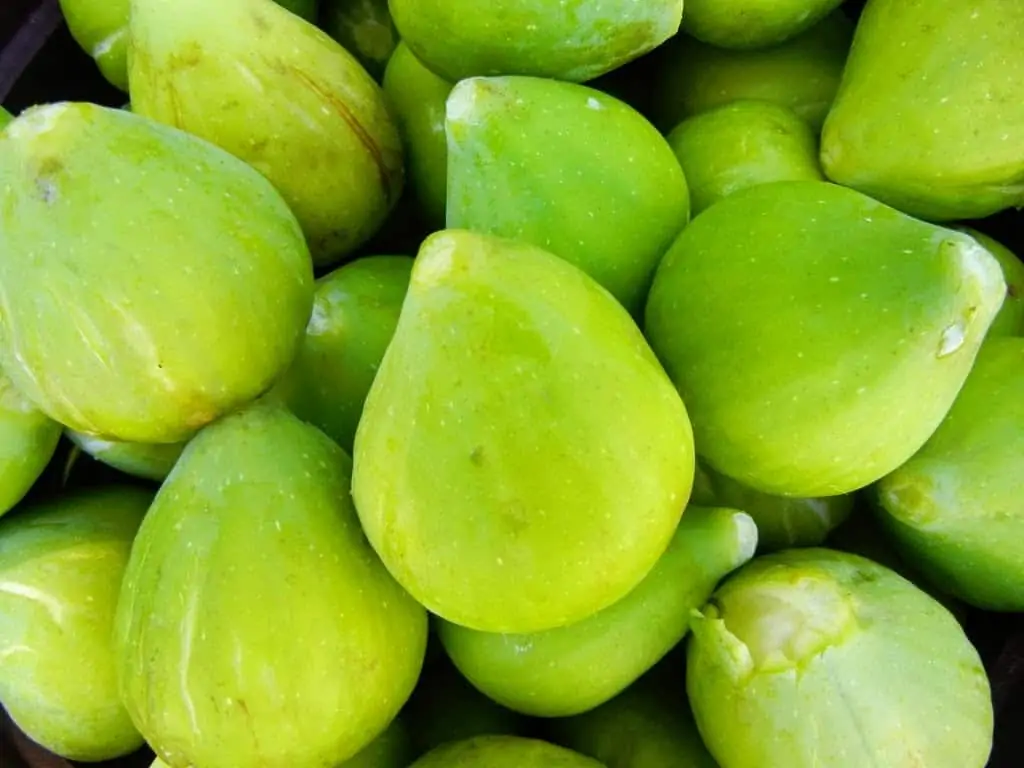
Cypress trees, umbrella trees, and pine trees are all beautiful, but the fig trees of Tuscany bear delicious fruit – fichi!
You can see the bright green figs in the spring, but they aren’t ready until June. Fig season in Tuscany continues into September.
You’ll see a few fig dishes on menus (including prosciutto-wrapped figs), but our favorite ways to eat them are fresh from the tree (or fruit stand) or as fig gelato!
Good To Know: While it’s tempting to pick them from trees, please don’t take figs from someone’s property! I can tell you from personal experience, it’s so sad to watch figs grow and then, when they’re finally ready – you walk into your field and find someone’s picked them all. You can find fresh figs at a fruit stand (fruttivendolo) or grocery store during fig season.
Language Note: Be careful with your Italian pronunciation for fig – fico. It ends in ‘o,’ not ‘a.’ The word with the ‘a’ ending is a vulgar term for female anatomy.
Other Trees in Tuscany
- Elderflower Trees (sambuco) – the Northern Italian Hugo spritz cocktail uses elderflower syrup
- Hazelnut Trees (nocciola) – a main ingredient in Nutella
- Loquat (Japanese Plum) Trees (nespola)
- Cherry Trees (ciliegia)
- Persimmon Trees (cachi) – they provide a gorgeous orange pop of color in the dreary winter months in Tuscany
Fun Facts about Trees in Italy
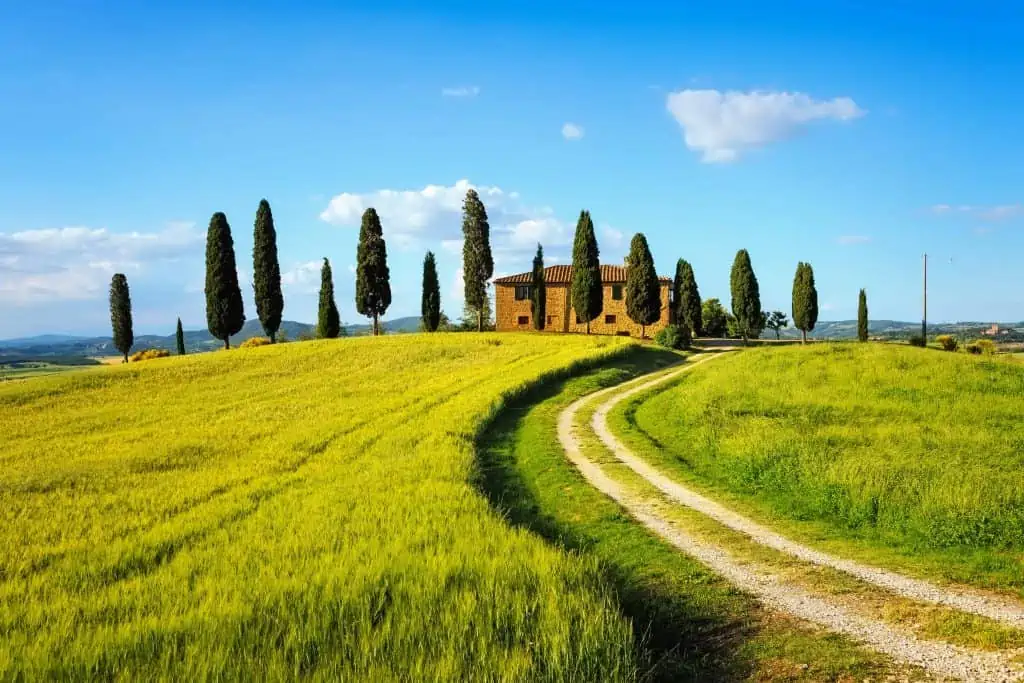
Disclaimer – I don’t have sources for all of these. Some of these ‘facts’ come from local guides, and they may be more ‘legend’ than ‘fact!’
Cypress Trees
- Cypress trees attract birds.
- To many, the Italian cypress tree represents eternal life.
- Cypress trees are planted along roads and around cemeteries because their roots grow down, so they won’t disrupt road surfaces or graves.
- Male cypress trees are tall and thin while female cypress trees are short and squatty.
- The Phoenicians believed the cypress tree symbolized the eternal flame.
- The Etruscans decorated their tombs with cypress trees.
- Cypress tree wood was used for coffins and shrines. The trees were welcome near burial sites, as the fragrant resin helped cover up unpleasant odors.
Olive Trees
- The olive branch is a symbol of peace. It’s on many flags, including the United Nations flag.
- The witch’s olive tree of Magliano (Maremma), is said to be around 3500 years old. It has a circumference of 8.5 meters and it’s 10 meters tall!
- Olive trees need to be pruned annually because the olive fruit needs consistent sunlight in order to grow.
- Often an olive tree will produce fruit only every other year, or will have a high-yield year followed by a low-yield year.
Umbrella Pines
- The umbrella pine was used in shipbuilding during Roman times.
- Pine nuts are one of the most labor-intensive nuts to harvest – that’s why they’re so expensive.
- It’s possible to overdo it with pine nuts! Some people get ‘pine mouth’ or ‘pine nut syndrome,’ which is a bitter or metallic aftertaste after consuming pine nuts that can last for up to two weeks.
Fig Trees
- Fig trees symbolize fertility and abundance.
- Some believe that figs – not apples – were the forbidden fruit in the Garden of Eden (Bible).
- The flowers of the fig tree are inside the fruit.
- Figs are often used as a cure for constipation.
Read more Facts about Tuscany!
Where to Photograph Trees in Tuscany
Tuscan Trees to Photograph
- Cypress trees in the Val d’Orcia (clusters – like the San Quirico d’Orcia cypress trees, cypress-lined roads – like the one near Monticchiello – and driveways)
- Guinigi Tower (Lucca), with its tree-topped roof
- Twin Sequoia at Castello di Sammezzano (Reggello)
- Trees at the Pistoia Nursery Park
- Oak of the Witches (Capannori)
- Witch’s Olive Tree (Magliano)
- Checche Oak (Pienza)
Map of Tuscan Trees to Photograph
Good To Know: Many of these places are on dirt roads or are best photographed by doing a little bit of walking. If you’ve got a rental car, make sure it’s fit for traveling on dirt/gravel roads (strade bianche). And have comfortable walking shoes. Sometimes you’ll need to park and walk along the (possibly busy) road to get to the perfect spot.
Many of these sites are located in Southern Tuscany in the Val d’Orcia. If you’re visiting the area, be sure to check out the villages of Pienza, Montepulciano, and Montalcino!
If you’re planning on driving in Italy, check out our posts:
Tips for Tuscany Car Rental
Renting a Car in Italy
Italian Gas Stations and Getting Gas in Italy
Important Italian Road Signs
Driving in Italy
International Driving Permit for Italy
Renting a Car in Italy with a US Driver’s License
You may also want to seek out some Outdoor Art in Tuscany to photograph
Other Plants to See and Photograph in Tuscany
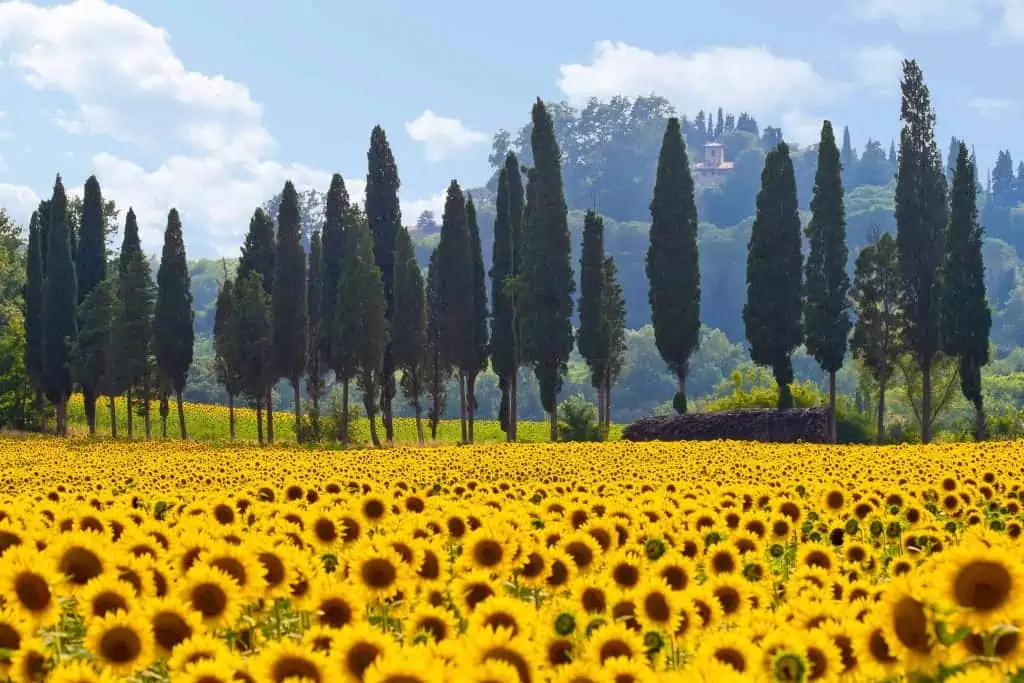
Disclaimer: These are approximate times! The flowers and plants will bloom depending on the weather.
Sunflowers
Tuscan sunflowers are full and blooming from late June to early August. It’s difficult to list specific places because farmers rotate their crops, so the specific fields change.
Some areas that traditionally have beautiful fields (although you can find them everywhere in Tuscany!):
- Val di Chiana (especially around Cortona)
- Val d’Orcia (especially around Pienza, Montepulciano, Montalcino)
- Maremma
- Mugello
- Along the FI-PI-LI highway that runs from Florence to Pisa/Livorno.
- Versilia
The best thing to do is check in with your accommodation. They’ll be able to point you in the direction of the sunflower fields in your area for that particular year.
Good To Know: Sunflowers are called girasoli in Italian, which is ‘turn with the sun.’
Red Poppies
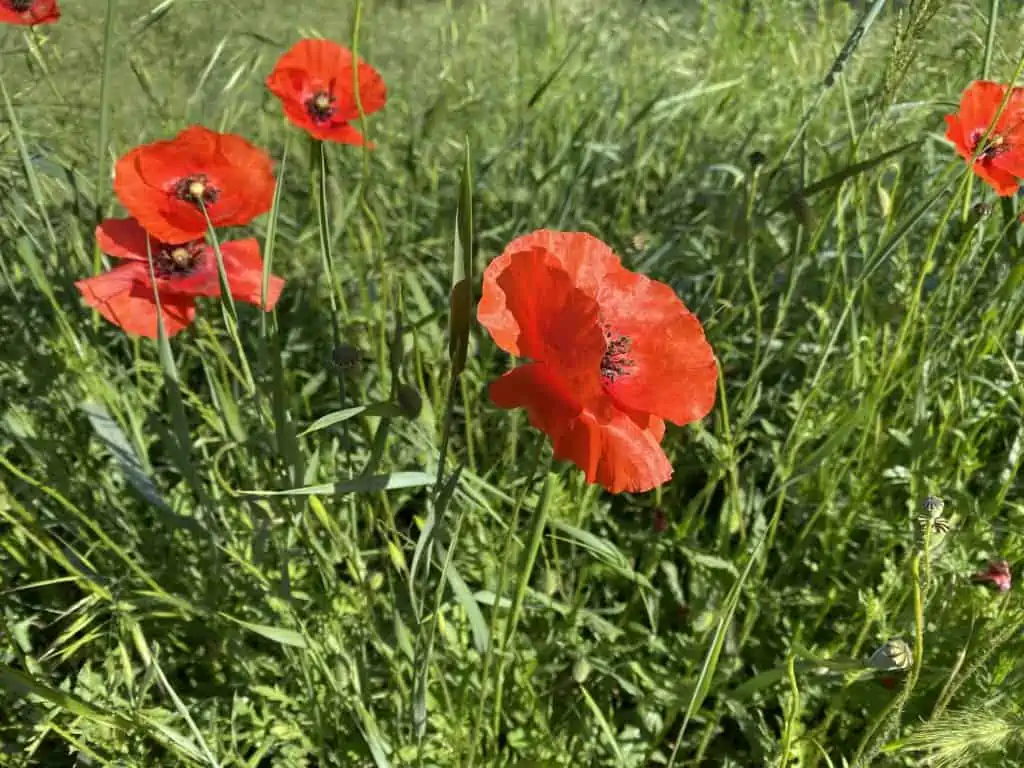
Red poppies (papaveri in Italian) bloom throughout Tuscany in April, and especially May. You can see them in large fields, and they’re also gorgeous along roadsides and ‘popping’ out between cracks in stone walls.
Wisteria Vines
Commonly mistaken for trees, wisteria are actually vines. They have an intoxicating scent, and the beautiful, delicate blooms are in full-force in April and May.
Good To Know: One of the best places to see wisteria is in the Bardini Gardens in Florence.
Jasmine
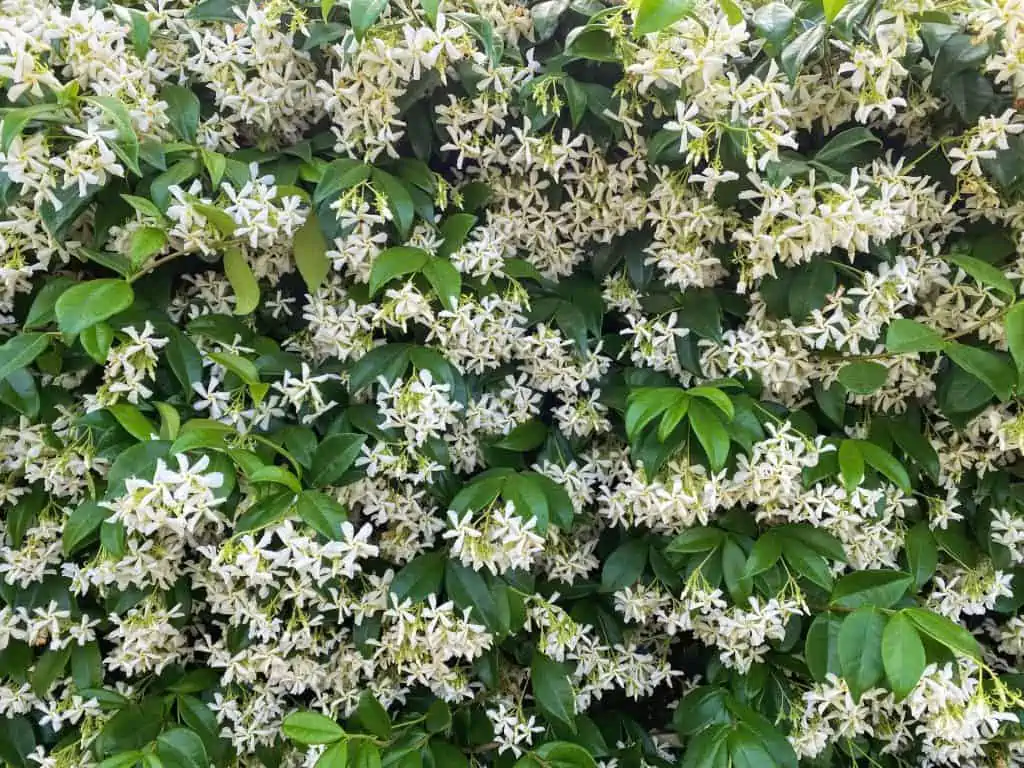
Jasmine is a deciduous vine that blooms in April, May, and June in Tuscany.
Roses
Roses are at their best in May and June. In Tuscany, the best places to see rose are at Florence’s rose garden, plus gardens of private homes in Tuscany and even in the vineyards.
Good To Know: If you visit Florence’s Rose Garden in May, walk to the other side of Piazzale Michelangelo and check out the Iris Garden, in full bloom in May (it opens in late-April). Read more about the Best Gardens in Florence.
Rapeseed
From a distance, fields of rapeseed (colza in Italian) look like fields of sunflowers, but when you get close, you’ll see the yellow-blanketed field isn’t full of girasoli. Rapeseed oil is used for frying in Tuscany. It’s usually labeled as canola oil in the US.
Plant Nurseries in Tuscany
Pistoia, in Northern Tuscany, is known for its plant nurseries (vivai). You can visit them as a client, or just to walk around and look at the beautiful plants, trees, and flowers.
The most famous (globally) is Vannucci Piante. Vannucci runs the Pistoia Nursery Park, a lovely park with trails and events that are worth a stop, especially if you are traveling with kids!
Good To Know: Traveling with children? Pistoia is also home to Tuscany’s best zoo, the Pistoia Zoo. And, the Pinocchio Park is also not far.
Learn more about Visiting the Pistoia Zoo and Pinocchio Park in Collodi!
Trees in Tuscany FAQ
You can see many of Tuscany’s famous (and not-so-famous) sites without your own car. Read about How to Visit Tuscany Without a Car.
The trees growing along the roads in Tuscany are Mediterranean cypress trees.
The tall, skinny trees you see throughout Tuscany are Mediterranean cypress trees.
Olive trees typically bloom in Tuscany in April or May.
The elderflower trees of Tuscany usually bloom in June.
The pine trees you see in Tuscany are umbrella pines.
Some nurseries have also begun to offer Christmas trees in pots that are collected after the holidays, replanted, and sold again the following year. You can even request to have the same tree!
Unfortunately, some large umbrella pines are removed for safety issues. For example, a stretch of gorgeous umbrella pines along the lungarno in Florence was removed because some of them fell after a large storm and others were deemed unstable.
We have had a few removed from our small Tuscan town’s park because a large one fell during the day, almost harming a family having a picnic. They’re beautiful, and provide wonderful shade, but some of the larger, unstable ones must be removed.
There is also talk of some Italian cities removing them because of their ties to fascism (many umbrella pines were planted in cities under Mussolini’s direction). But, most are simply removed because they are safety hazards.
